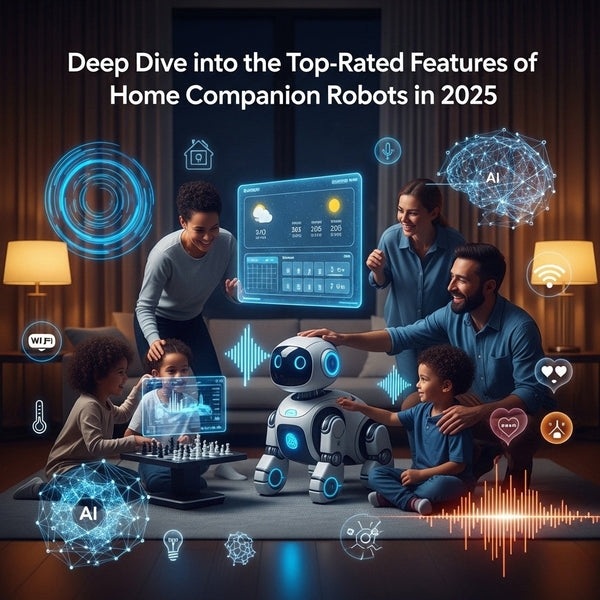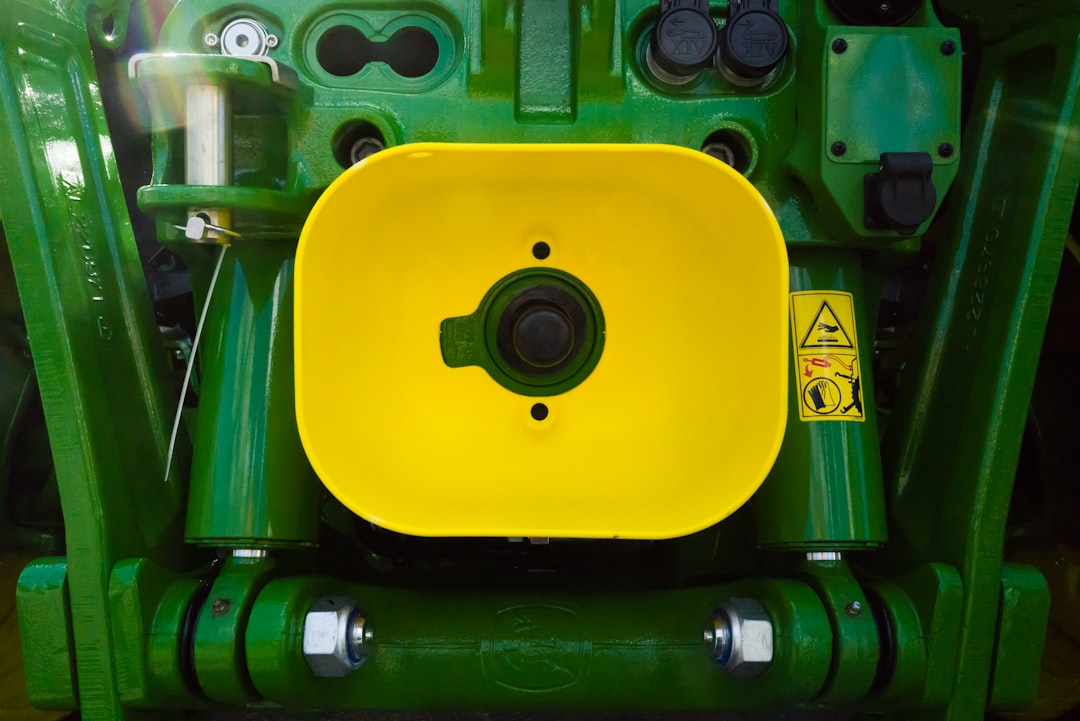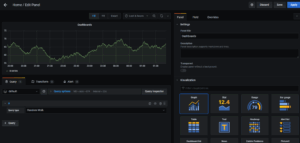The Next Wave of Intelligence: Are Personal AI Robots Finally Here?
For decades, the concept of a personal robot companion has been a cornerstone of science fiction, a symbol of a futuristic, automated life. From Rosie the Robot in “The Jetsons” to C-3PO in “Star Wars,” these mechanical assistants promised to simplify our lives, manage our homes, and even offer companionship. Today, that fiction is rapidly converging with reality. The latest AI Personal Robots News signals a pivotal shift from single-purpose devices, like robotic vacuums, to multifaceted AI companions designed to be the central nervous system of our connected homes. These emerging devices are not just mobile speakers or cameras on wheels; they are sophisticated platforms integrating advanced AI, spatial awareness, and proactive assistance, promising to redefine our relationship with technology in our most personal spaces.
This evolution is fueled by a perfect storm of technological advancements: the miniaturization of powerful processors for on-device processing, breakthroughs in large language models (LLMs) and computer vision, and the maturation of the broader smart home ecosystem. As we stand on the cusp of this new era, it’s crucial to look beyond the initial “wow” factor and delve into the technical underpinnings, practical applications, and profound implications of welcoming an autonomous AI entity into our daily lives. This article explores the current state of personal AI robots, dissects the technology that powers them, and analyzes what their arrival means for the future of smart living, privacy, and human-computer interaction.
Section 1: From Task-Oriented Bots to Proactive Companions: The Evolution of Home Robotics
The journey to the modern AI companion robot has been a gradual but deliberate one. For years, the most visible form of home robotics has been task-specific. The latest Robotics Vacuum News showcases devices with incredible navigation and cleaning efficiency, but their function remains singular. Similarly, smart speakers brought voice-based AI into our homes, but they are stationary, lacking physical presence and environmental awareness. The new generation of personal robots represents the convergence of these previously separate domains—mobility, environmental sensing, and conversational intelligence—into a single, cohesive entity.
Key Technological Leaps Driving the Change
Several key innovations are enabling this transition from simple automation to intelligent companionship. Understanding these is essential to appreciating the complexity and potential of these new devices.
- Edge AI and Processing Power: Early smart devices relied heavily on the cloud for AI processing. The latest AI Edge Devices News highlights a critical shift towards powerful, on-device neural processing units (NPUs). This allows robots to perform complex tasks like object recognition, facial identification, and natural language understanding locally, which significantly reduces latency and enhances privacy by keeping sensitive data within the home.
- Advanced Sensor Fusion: A personal robot’s ability to navigate and understand its environment depends on a sophisticated suite of sensors. This includes LiDAR for precise 3D mapping, high-resolution cameras for object and person recognition (a major topic in AI-enabled Cameras & Vision News), and microphone arrays for sound source localization. The robot’s AI fuses data from all these sources—a core concept in AI Sensors & IoT News—to build a dynamic, real-time understanding of the home.
- Generative AI and Natural Interaction: The rise of LLMs has revolutionized how we interact with machines. Instead of rigid, command-based interactions, users can communicate with these robots more naturally. The robot can understand context, remember past conversations, and even proactively initiate communication based on its observations, making it feel less like a tool and more like a true assistant, a recurring theme in AI Assistants News.
- Projection and Display Technologies: A key differentiator for many emerging companion robots is their ability to project information onto surfaces. A robot might project a video call onto a wall, display a recipe on the kitchen counter, or project a calming visual for a yoga session. This turns any surface into a potential smart display, moving beyond the physical limitations of a built-in screen and integrating more seamlessly into the environment.
Section 2: The Anatomy of an AI Home Companion: A Technical Breakdown
To truly understand the capabilities and limitations of these robots, we must look under the hood. A personal AI robot is a complex system of interconnected hardware and software, where each component plays a crucial role in its overall function. This deep integration is what separates it from a simple collection of smart gadgets.
The ‘Brain’: A Hybrid AI Architecture

The “brain” of a modern personal robot typically employs a hybrid AI model. Routine tasks like navigation, obstacle avoidance, and basic object recognition are handled by on-device processors. This ensures core functionality remains intact even without an internet connection. For more complex queries, such as answering a nuanced question or generating a creative summary, the robot may tap into powerful cloud-based models. The latest AI Research / Prototypes News often focuses on optimizing this balance, ensuring swift local processing for immediate tasks while leveraging the vast knowledge of the cloud for deeper intelligence. This hybrid approach is a best-of-both-worlds solution, balancing responsiveness, privacy, and capability.
The ‘Senses’: Perceiving the World in High Fidelity
A robot’s perception of the world is only as good as its sensors. The sensor suite is the robot’s primary interface with the physical world, making it a critical area of innovation.
- Vision Systems: Central to the robot’s function is its camera. We’re seeing a trend towards high-dynamic-range (HDR) cameras capable of seeing clearly in both bright and low-light conditions. The latest AI Cameras News discusses how onboard AI algorithms can instantly analyze this video feed to identify people, pets, and specific objects (like a dropped phone or a spilled drink), and even interpret human posture or emotion.
- Spatial Awareness: LiDAR (Light Detection and Ranging) sensors are crucial for creating accurate 3D maps of the home. This allows the robot to navigate efficiently, understand room layouts, and remember the location of furniture. This spatial data is fundamental for advanced tasks, like being asked to “go to the living room and check on the dog.”
- Audio Perception: Advanced microphone arrays, a topic often covered in AI Audio / Speakers News, allow the robot to not only hear commands from across a room but also identify the direction of the sound. It can distinguish a user’s voice from background noise like a television, and some can even recognize acoustic events like a smoke alarm or breaking glass, triggering an alert.
The ‘Body’: Mobility and Physical Interaction
The physical form of the robot dictates how it moves and interacts with its environment. While we are still far from the humanoid robots of science fiction, current designs are highly optimized for the home. Spherical or cylindrical rolling designs offer a small footprint and high maneuverability, capable of navigating tight corners and transitioning between different floor types. The robot’s primary method of interaction is often through its integrated projector and high-quality speaker system, turning it into a mobile communication and entertainment hub. This is a fascinating intersection of robotics and entertainment, relevant to AI in Gaming Gadgets News and AI Toys & Entertainment Gadgets News, as the robot could project a game onto the floor for children or act as a dynamic participant in an AR/VR experience.
Section 3: A Day in the Life: Real-World Scenarios and Smart Home Integration
The true value of a personal AI robot is not in any single feature, but in its ability to seamlessly weave itself into the fabric of daily life. It acts as an orchestrator for the entire smart home ecosystem, creating a more intuitive and proactive living experience. Let’s walk through a hypothetical day.
Morning Routine and Productivity
Your day begins not with a jarring alarm, but with the robot gently rolling into your bedroom and projecting a soft, simulated sunrise on the ceiling, a concept straight out of AI Lighting Gadgets News. It verbally provides a summary of your calendar, the weather forecast, and traffic conditions. As you head to the kitchen, it follows, projecting a news feed on the wall while it signals your smart coffee maker to start brewing. This level of integration with Smart Appliances News and AI Kitchen Gadgets News transforms disparate gadgets into a coordinated system. For those working from home, it can act as a mobile telepresence device, following you to your home office and projecting video calls, a development relevant to AI Office Devices News.
Home Management and Security

While you’re away, the robot enters patrol mode, a key feature discussed in AI Security Gadgets News. It roams the house, using its cameras to provide a live feed to your phone, a significant upgrade over stationary security cameras. It can use its AI to detect unusual activity and send you an alert. It can also integrate with AI Pet Tech News by recognizing when your pet is low on food and activating a smart feeder, or simply engaging the pet in play to alleviate separation anxiety. It can even monitor your indoor plants, a niche but growing area of AI Gardening / Farming Gadgets News, reminding you when they need water.
Health, Wellness, and Entertainment
In the evening, the robot becomes a wellness and entertainment companion. It can lead you through a guided meditation or a workout routine, projecting the instructor onto the floor and using its camera to offer feedback on your form, a prime example for AI Fitness Devices News. For families, it can become an educational tool, a topic for AI Education Gadgets News, projecting interactive lessons or games. It can even help with personal wellness, reminding elderly users to take medication or connecting them instantly with family via video call, showcasing its potential in AI for Accessibility Devices News and Health & BioAI Gadgets News.
Section 4: The Road Ahead: Challenges, Considerations, and Future Trends
Despite the immense promise, the path to mass adoption is paved with significant challenges and important considerations for both consumers and developers. The success of this category will depend on how effectively the industry addresses these hurdles.
Pros and Cons: A Balanced Perspective

Pros:
- Centralized Smart Home Control: Acts as a single, mobile interface for all connected devices, simplifying home automation.
- Proactive Assistance: Can anticipate needs and act autonomously, moving beyond simple reactive commands.
- Enhanced Security and Monitoring: Provides comprehensive home monitoring that is more dynamic than fixed cameras.
- Companionship and Accessibility: Can offer a sense of presence and assistance for the elderly or those with mobility issues.
Cons:
- Privacy and Data Security: An always-on, mobile camera and microphone in the home raises significant privacy concerns. Secure on-device processing and transparent data policies are non-negotiable.
- Cost and Practical Utility: Early models will be expensive. They must prove their value beyond novelty to justify the price tag and avoid becoming a high-tech gimmick.
- Physical Limitations: Current models cannot climb stairs, open doors, or manipulate objects, limiting their utility in multi-story homes or for tasks requiring physical interaction.
- Reliability and Maintenance: As a complex mechanical device, it will be subject to wear and tear, requiring maintenance and robust customer support.
Future Integration and Ecosystem Expansion
The future of personal robots lies in their integration with other emerging technologies. Imagine your robot syncing with your Wearables News-featured smartwatch to monitor your vitals after a workout. Or consider its role in the world of AR/VR AI Gadgets News, where it could act as a physical anchor in a mixed-reality environment, bringing digital objects into your physical space. As the Smart City / Infrastructure AI Gadgets News landscape evolves, your robot could receive data about local power grid usage to optimize your home’s energy consumption, a topic relevant to AI for Energy / Utilities Gadgets News. The possibilities for cross-platform synergy are immense and will be a key driver of innovation.
Conclusion: The Dawn of the Empathetic Home
The emergence of the AI personal robot marks a significant milestone in our journey towards a truly intelligent and responsive living environment. These devices represent the culmination of decades of research in robotics, AI, and user interface design. While challenges around privacy, cost, and practical utility remain, the trajectory is clear. We are moving from a world of passive, command-driven smart devices to one of proactive, context-aware AI companions that can understand and anticipate our needs. The latest AI Personal Robots News is not just about a new gadget; it’s about a fundamental shift in the human-technology relationship within our most personal sanctuary. As these robots become more capable and accessible, they have the potential to become indispensable partners, making our homes more efficient, secure, and, ultimately, more human-centric.










